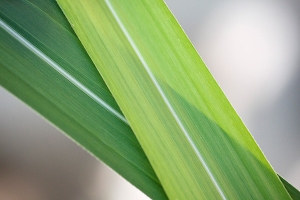Lighter colored upper leaves may be crop ‘photosynthesis hack’
 By combining computing and genetic engineering, researchers at the University of Illinois and the CAS-MPG Partner Institute of Computational Biology in Shanghai are learning how they can boost photosynthetic efficiency of plants, and therefore, production.
By combining computing and genetic engineering, researchers at the University of Illinois and the CAS-MPG Partner Institute of Computational Biology in Shanghai are learning how they can boost photosynthetic efficiency of plants, and therefore, production.
There has never been a better time to try this, said University of Illinois plant biology professor Stephen P. Long, who co-wrote the report, which was published in the journal Cell.
"We now know every step in the processes that drive photosynthesis in C3 crop plants such as soybeans and C4 plants such as maize," Long said. "We have unprecedented computational resources that allow us to model every stage of photosynthesis and determine where the bottlenecks are, and advances in genetic engineering will help us augment or circumvent those steps that impede efficiency."
Substantial progress has already been made in the lab and in computer models of photosynthesis, Long said. Already, researchers have placed a gene in crop plants that can boost the photosynthetic rate by 30%.
Researchers also are looking to other organisms for tips on photosynthesis boosts – some bacteria and algae contain pigments that utilize more of the solar spectrum than plant pigments do. If added to plants, those pigments could bolster the plants' access to solar energy.
Some scientists also are trying to engineer C4 (like corn) photosynthesis in C3 (like soybean) plants, but this means altering plant anatomy, changing the expression of many genes and inserting new genes from C4 plants, Long said.
"Another, possibly simpler approach is to add to the C3 chloroplast the system used by blue-green algae," he said.
This chloroplast would increase the activity of a certain enzyme that computer models suggest could increase photosynthesis as much as 60%.
Computer analyses of the way plant leaves intercept sunlight have revealed other ways to improve photosynthesis.
Many plants intercept too much light in their topmost leaves and too little in lower leaves. This probably allows them to outcompete their neighbors, but in a farmer's field such competition is counterproductive, Long said.
Studies headed by Illinois plant biology professor Donald Ort aim to make plants' upper leaves lighter, allowing more sunlight to penetrate to the light-starved lower leaves.
"The computer model predicts that by altering this system by up-regulating some genes and down-regulating others, a 60% improvement could be achieved without any additional resource -- so 60% more carbon could be assimilated for no more nitrogen," Long said.
Another U of I plant biology professor, Amy Marshall-Colon, noted that the next step will be to virtually simulate complex interactions among biological scales using an in silico model.
"This type of model is essential to fill current gaps in knowledge and better direct our engineering efforts," she said.
While many scientific, political and regulatory hurdles remain for plants engineered to do a better job of converting the sun's energy into biomass, the work should be undertaken now, Long said.
"If we have a success today, it won't appear in farmers' fields for 15 years at the very earliest," he said. "We have to be doing today what we may need in 30 years."
Source: Farm Futures
RELATED RIPE OBJECTIVES
Optimizing Canopies